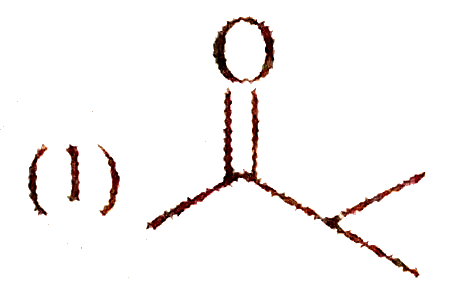The product of the given reaction ,
CH3−∣CH3∣C∣OH−CH3∣C∣NH2−CH3HNO2−−−→ Product is :
CH3−CH3∣C∣OH−CH3∣C∣OH−CH3
CH3−O∣∣C−CH3∣C∣CH3−CH3
CH3−CH3∣C∣OH−C∣CH3H−CH3
CH3−C∣CH3=C∣CH3−CH3
The correct Answer is:B
To solve the problem, we will analyze the reaction of the given compound with HNO2 step by step.
Step 1: Identify the Reactants
The reactant is a compound with both an alcohol (OH) and an amino group (NH2). The structure can be represented as:
CH3−C(OH)(NH2)−C(CH3)(CH3)
Step 2: Reaction with HNO2
When HNO2 (Nitrous acid) is introduced, it reacts with the amino group (NH2). This reaction is characteristic of primary amines, leading to the formation of a diazonium ion.
Step 3: Mechanism of Reaction
1. Formation of Diazonium Ion:
- The NH2 group reacts with HNO2, which can be represented as HONO.
- The nitrogen in NH2 acts as a nucleophile and attacks the electrophilic nitrous acid, leading to the formation of a diazonium ion.
2. Formation of Carbocation:
- The diazonium ion is unstable due to the presence of alkyl groups, which leads to the loss of nitrogen gas (N2) and the formation of a carbocation.
Step 4: Rearrangement of Carbocation
- The carbocation formed is subject to rearrangement to form a more stable carbocation. In this case, a methyl shift occurs, where a methyl group from one carbon moves to the adjacent carbon, stabilizing the positive charge.
Step 5: Nucleophilic Attack by Water
- Water, acting as a nucleophile, attacks the carbocation, leading to the formation of a geminal diol (a compound with two hydroxyl groups on the same carbon).
Step 6: Dehydration to Form Ketone
- The geminal diol is unstable and can lose a molecule of water, resulting in the formation of a ketone.
Final Product
The final product after the reaction with HNO2 and subsequent rearrangements and dehydration is:
CH3−C(=O)−C(CH3)(CH3)
This is a ketone.
Conclusion
The correct answer for the product of the reaction is a ketone derived from the original compound.
---
The reactant is a compound with both an alcohol (OH) and an amino group (NH2). The structure can be represented as:
CH3−C(OH)(NH2)−C(CH3)(CH3)
When HNO2 (Nitrous acid) is introduced, it reacts with the amino group (NH2). This reaction is characteristic of primary amines, leading to the formation of a diazonium ion.
1. Formation of Diazonium Ion:
- The NH2 group reacts with HNO2, which can be represented as HONO.
- The nitrogen in NH2 acts as a nucleophile and attacks the electrophilic nitrous acid, leading to the formation of a diazonium ion.
- The diazonium ion is unstable due to the presence of alkyl groups, which leads to the loss of nitrogen gas (N2) and the formation of a carbocation.
- The carbocation formed is subject to rearrangement to form a more stable carbocation. In this case, a methyl shift occurs, where a methyl group from one carbon moves to the adjacent carbon, stabilizing the positive charge.
- Water, acting as a nucleophile, attacks the carbocation, leading to the formation of a geminal diol (a compound with two hydroxyl groups on the same carbon).
- The geminal diol is unstable and can lose a molecule of water, resulting in the formation of a ketone.
The final product after the reaction with HNO2 and subsequent rearrangements and dehydration is:
CH3−C(=O)−C(CH3)(CH3)
This is a ketone.
The correct answer for the product of the reaction is a ketone derived from the original compound.
Similar Questions
Knowledge Check
CH3−CH3∣C∣OH−CH3∣C∣NH2−CH3HNO2−−−→Δ?
A B
B C
C D
D
Major product of the given reaction is
CH3−CH3∣C∣CH3−CH∣CI−CH3C2H5O−−−−−−→ACH3−CH3∣C∣CH3−CH∣OC2H5−CH3BCH3−CH3∣C∣CH3−CH=CH2CCH3−CH3∣C=C∣CH3−CH3DCH3−CH3∣C∣OC2H5−CH3∣CH−CH3The major product of the following reaction is:
CH3−CH3∣C∣H−CHCH3∣BrCH3OH−−−−→ACH3−CH3∣C∣H−CHCH3∣OCH3BCH3−CH3∣C=CHCH3CCH3−CH3∣C∣OCH3−CH2CH3DCH3−CH3∣C∣H−CH=CH2
IUPAC name of CH3−CH3∣C∣OH−CH2−CH3
View SolutionThe IUPAC name of
CH3Ch2−H∣C∣CH3−C4H9∣C∣CH3−CH3
is
View SolutionProduct of the following reaction is -⎡⎢ ⎢⎣CH3−CH3∣N∣CH3−CH∣CH3−CH2−CH3⎤⎥ ⎥⎦+OH−Δ−−→
View SolutionThe IUPAC name of
CH3C∣OHH−CH3∣CH−CH3∣C∣OH−CH3 is
View SolutionH3C−CH3∣C∣CH3−C∣OHH−CH3HBr−−→(A) Product (A) is
View Solution

